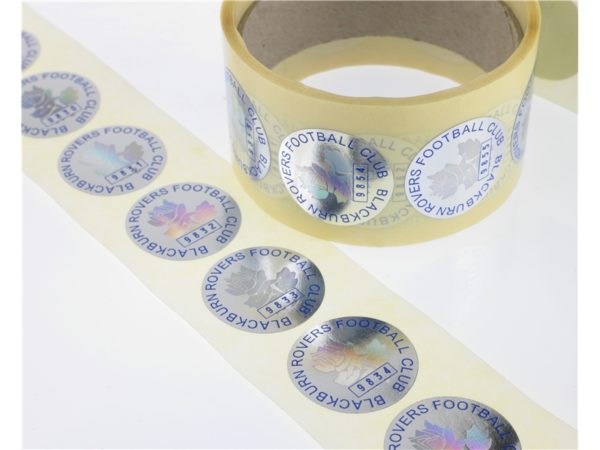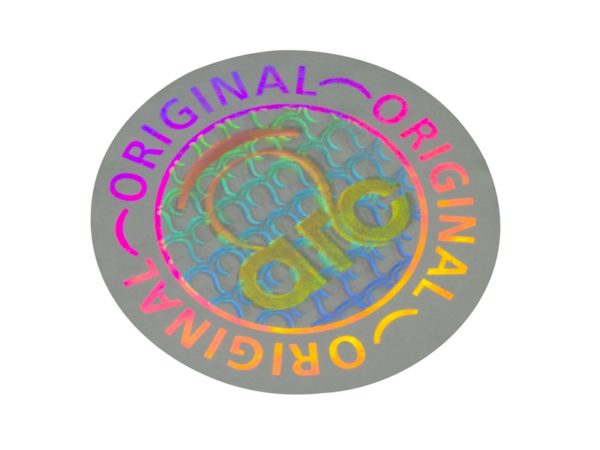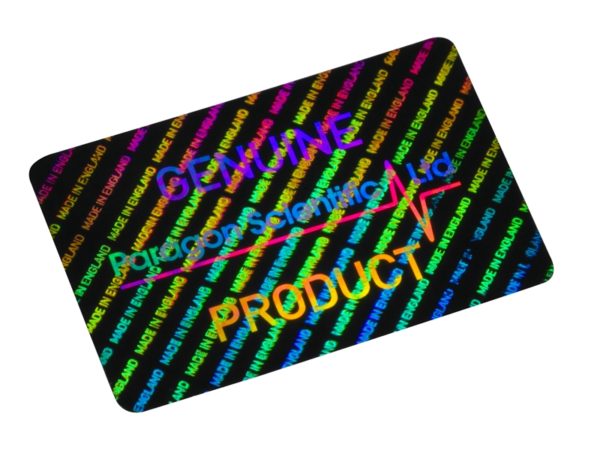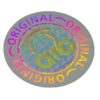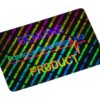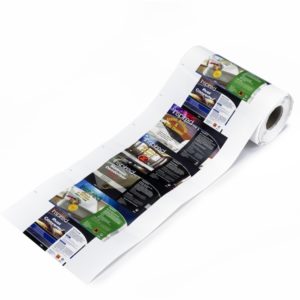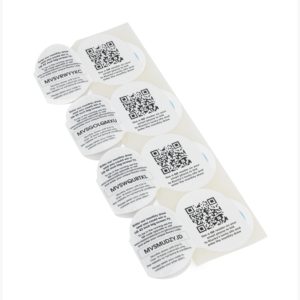Digital Holographic Labels
Home / Full Product Range / Digital Labels / Digital Holographic Labels
Labelservice are major suppliers of custom holographic labels for use as either decorative or security purposes. We supply bespoke designs and images tailored to your specifications, in either short or longer runs.
We can either digitally print single colour or full colour onto several stock holographic base materials, or we can print a hologram of your choice onto a white or clear label.
We can produce your logos or corporate identity with no minimum quantity, supllied on rolls or sheets. Digital technology also means variable text, coding or imagery can be added.
Please contact us for further information or samples.
Holographic Labels FAQs
Holographic labels are specialised stickers made using a holographic film that reflects light in a unique way, creating a multi-dimensional, shimmering effect. Often used for branding, security, and decorative purposes, these labels are not only visually appealing but can also serve as an anti-counterfeit measure.
Traditional holographic labels are created through an embossing process on a metallic surface, ideal for larger batches. Digital holographic labels use digital printing, offering more design flexibility and cost-effectiveness for shorter runs or custom designs. The choice of which process to go with depends on production volume and design requirements.
Holographic labels are produced through an embossing process. First, a master shim with a specific holographic pattern is pressed onto a metallic film, creating the holographic effect. After embossing, the film is printed with the desired design using either traditional or digital printing methods. The final label combines the holographic pattern with the printed design, providing both visual appeal and product authentication.
Retail and Fashion: For branding and making products stand out on shelves.
Pharmaceuticals: To ensure product authenticity and deter counterfeiting.
Electronics: For product identification and security.
Cosmetics: To enhance packaging appeal and verify product genuineness.
Automotive: For parts authentication and branding.
Food and Beverage: To add a premium look to packaging and as a seal of authenticity.
Events and Entertainment: As tickets or passes to prevent duplication.
The primary purposes are branding, product differentiation, security, and anti-counterfeiting measures.
Holographic sticker labels are a popular choice for security measures. Their intricate patterns are tough to replicate, and custom designs offer an additional layer of security. Many labels come with embedded features like microtext or UV inks, making duplication extremely challenging. Additionally, tamper-evident designs leave clear signs if interfered with. The multi-dimensional shine of these labels which are hard to mimic with standard printing, coupled with potential verification tools, ensures they act as a trusted mark of authenticity.
Yes, holographic labels can be made both weatherproof and waterproof. They are often manufactured with protective coatings and durable adhesives to withstand rain, sunlight, or temperature fluctuations. However, the level of resistance can vary based on the specific materials used and the intended application, so it’s advisable to specify these requirements when ordering.
Absolutely. Holographic labels can be customised to include barcodes or QR codes. Modern printing technology allows for the integration of these codes without compromising the label’s holographic effect. Holographic labels with scannable QR codes are ideal for product tracking, authentication, and promotional activities.
Holographic labels, due to their metallic and plastic components, are not inherently eco-friendly and can pose challenges in recycling. However, it is possible and due to advancements in label manufacturing there are more sustainable materials that can be used. It’s also important to ascertain what you mean by eco-friendly, whether the manufacturing process is eco-friendly, if the material is recyclable or made for recycled material, or whether the label is sustainable and or compostable. All of which are different things. Please ask us for more details.
Labelservice are major suppliers of custom holographic labels for use as either decorative or security purposes. We supply bespoke designs and images tailored to your specifications, in either short or longer runs.
We can either digitally print single colour or full colour onto several stock holographic base materials, or we can print a hologram of your choice onto a white or clear label.
We can produce your logos or corporate identity with no minimum quantity, supllied on rolls or sheets. Digital technology also means variable text, coding or imagery can be added.
Please contact us for further information or samples.
Holographic Labels FAQs
Holographic labels are specialised stickers made using a holographic film that reflects light in a unique way, creating a multi-dimensional, shimmering effect. Often used for branding, security, and decorative purposes, these labels are not only visually appealing but can also serve as an anti-counterfeit measure.
Traditional holographic labels are created through an embossing process on a metallic surface, ideal for larger batches. Digital holographic labels use digital printing, offering more design flexibility and cost-effectiveness for shorter runs or custom designs. The choice of which process to go with depends on production volume and design requirements.
Holographic labels are produced through an embossing process. First, a master shim with a specific holographic pattern is pressed onto a metallic film, creating the holographic effect. After embossing, the film is printed with the desired design using either traditional or digital printing methods. The final label combines the holographic pattern with the printed design, providing both visual appeal and product authentication.
Retail and Fashion: For branding and making products stand out on shelves.
Pharmaceuticals: To ensure product authenticity and deter counterfeiting.
Electronics: For product identification and security.
Cosmetics: To enhance packaging appeal and verify product genuineness.
Automotive: For parts authentication and branding.
Food and Beverage: To add a premium look to packaging and as a seal of authenticity.
Events and Entertainment: As tickets or passes to prevent duplication.
The primary purposes are branding, product differentiation, security, and anti-counterfeiting measures.
Holographic sticker labels are a popular choice for security measures. Their intricate patterns are tough to replicate, and custom designs offer an additional layer of security. Many labels come with embedded features like microtext or UV inks, making duplication extremely challenging. Additionally, tamper-evident designs leave clear signs if interfered with. The multi-dimensional shine of these labels which are hard to mimic with standard printing, coupled with potential verification tools, ensures they act as a trusted mark of authenticity.
Yes, holographic labels can be made both weatherproof and waterproof. They are often manufactured with protective coatings and durable adhesives to withstand rain, sunlight, or temperature fluctuations. However, the level of resistance can vary based on the specific materials used and the intended application, so it’s advisable to specify these requirements when ordering.
Absolutely. Holographic labels can be customised to include barcodes or QR codes. Modern printing technology allows for the integration of these codes without compromising the label’s holographic effect. Holographic labels with scannable QR codes are ideal for product tracking, authentication, and promotional activities.
Holographic labels, due to their metallic and plastic components, are not inherently eco-friendly and can pose challenges in recycling. However, it is possible and due to advancements in label manufacturing there are more sustainable materials that can be used. It’s also important to ascertain what you mean by eco-friendly, whether the manufacturing process is eco-friendly, if the material is recyclable or made for recycled material, or whether the label is sustainable and or compostable. All of which are different things. Please ask us for more details.


